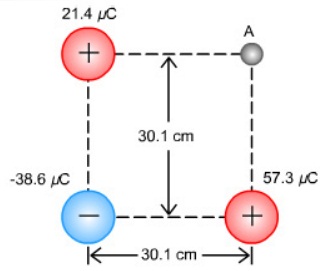Assignment:
Problems:
1. Pictured below are three point charges spaced equidistantly. All three charges have the same magnitude of charge a but the charge on the far right is negatively charged (that is, - 0). Rank the potential energy, from highest to lowest potential energy, at the four points indicated if a negative charge (- q) was to be placed there.

2. Pictured on the right are thee point charges Q1 = 21.4 μC, Q2= -38.6 μC, and Q3 = 57.3 μC arranged according to the figure on the right. Calculate the potential at point A in the figure.

3. Two plates of area 4.00 x 103 m2 are separated by a distance of 2.60 x 10-4 m. If a charge of 6.40 x 10-8 C is moved from one plate to the other, calculate the potential difference (voltage) between the two plates. Assume that the separation distance is small in comparison to the diameter of the plates.
4. Two plates of area 377 x 104 m2 each are separated by a distance 21.7 x 10-2 m. Calculate the capacitance of the capacitor.
5. You have two capacitors, one with capacitance 10.1 x 10-6 F and the other of unknown capacitance. You connect the two capacitors in series with a voltage difference of 325 V applied across the capacitors. You discover that, as a result, the unknown capacitor has a charge of 0.00119 C. Find its capacitance
6. Three uncharged capacitors with equal capacitances are combined in parallel. The combination is connected to a 5.73-V battery, which charges the capacitors. The charging process involves 1.09 x 10-4 C of charge moving through the battery. Find the capacitance of each capacitor.
7. A paper-filled capacitor is charged to a potential difference of 2.3 V and then disconnected from the charging circuit. The dielectric constant of the paper is 3.7. Keeping the plates insulated, the paper filling is withdrawn, allowing air to fill the capacitor instead. Find the resulting potential difference of the capacitor.
8. While continuing to keep the capacitor's plates insulated, an unknown substance is inserted between them. The plates then attain a potential difference that is 0.57 times the original potential difference (when paper filled the capacitor). What is this substance's dielectric constant?
9. Each plate of a parallel-plate capacitor is a square of side 0.0349 m and the plates are separated by 0.421 x 10-3 m. The capacitor is charged and stores 7.55 x 10-9 J of energy. Find the electric field strength inside the capacitor.